SCDM71-316 Structures: Analysis of Life Cycle Tower (LCT) ONE
VerifiedAdded on 2023/04/08
|6
|1065
|343
Report
AI Summary
This report provides a comprehensive analysis of the Life Cycle Tower (LCT) ONE, focusing on its structural design and material choices. It discusses the implementation of earthquake design and management systems, specifically lateral load resisting systems like bearing wall and dual systems. The report also explores the implications of using a timber flat plate system instead of a glulam beam system, considering factors such as service integration, floor height, material usage, and column placement. Furthermore, it outlines essential geotechnical tests conducted prior to the structure's design and construction, including direct shear tests, standard penetration tests, static cone penetration, vane shear tests, and groundwater condition analysis. These tests are crucial for determining the appropriate footing size, type, capacity, and length for the structure. This document is available on Desklib, a platform offering a range of study tools and solved assignments for students.
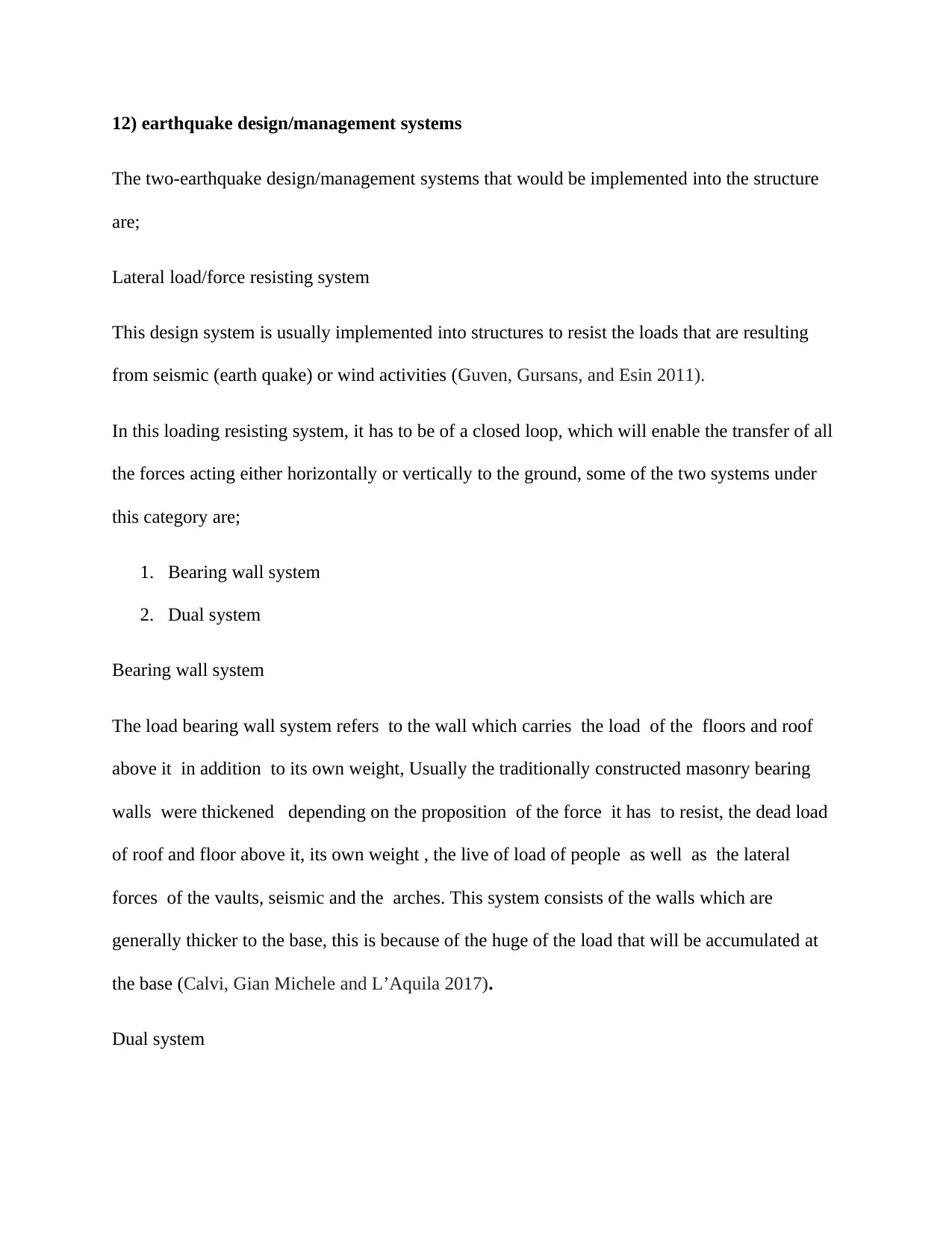
12) earthquake design/management systems
The two-earthquake design/management systems that would be implemented into the structure
are;
Lateral load/force resisting system
This design system is usually implemented into structures to resist the loads that are resulting
from seismic (earth quake) or wind activities (Guven, Gursans, and Esin 2011).
In this loading resisting system, it has to be of a closed loop, which will enable the transfer of all
the forces acting either horizontally or vertically to the ground, some of the two systems under
this category are;
1. Bearing wall system
2. Dual system
Bearing wall system
The load bearing wall system refers to the wall which carries the load of the floors and roof
above it in addition to its own weight, Usually the traditionally constructed masonry bearing
walls were thickened depending on the proposition of the force it has to resist, the dead load
of roof and floor above it, its own weight , the live of load of people as well as the lateral
forces of the vaults, seismic and the arches. This system consists of the walls which are
generally thicker to the base, this is because of the huge of the load that will be accumulated at
the base (Calvi, Gian Michele and L’Aquila 2017).
Dual system
The two-earthquake design/management systems that would be implemented into the structure
are;
Lateral load/force resisting system
This design system is usually implemented into structures to resist the loads that are resulting
from seismic (earth quake) or wind activities (Guven, Gursans, and Esin 2011).
In this loading resisting system, it has to be of a closed loop, which will enable the transfer of all
the forces acting either horizontally or vertically to the ground, some of the two systems under
this category are;
1. Bearing wall system
2. Dual system
Bearing wall system
The load bearing wall system refers to the wall which carries the load of the floors and roof
above it in addition to its own weight, Usually the traditionally constructed masonry bearing
walls were thickened depending on the proposition of the force it has to resist, the dead load
of roof and floor above it, its own weight , the live of load of people as well as the lateral
forces of the vaults, seismic and the arches. This system consists of the walls which are
generally thicker to the base, this is because of the huge of the load that will be accumulated at
the base (Calvi, Gian Michele and L’Aquila 2017).
Dual system
Paraphrase This Document
Need a fresh take? Get an instant paraphrase of this document with our AI Paraphraser
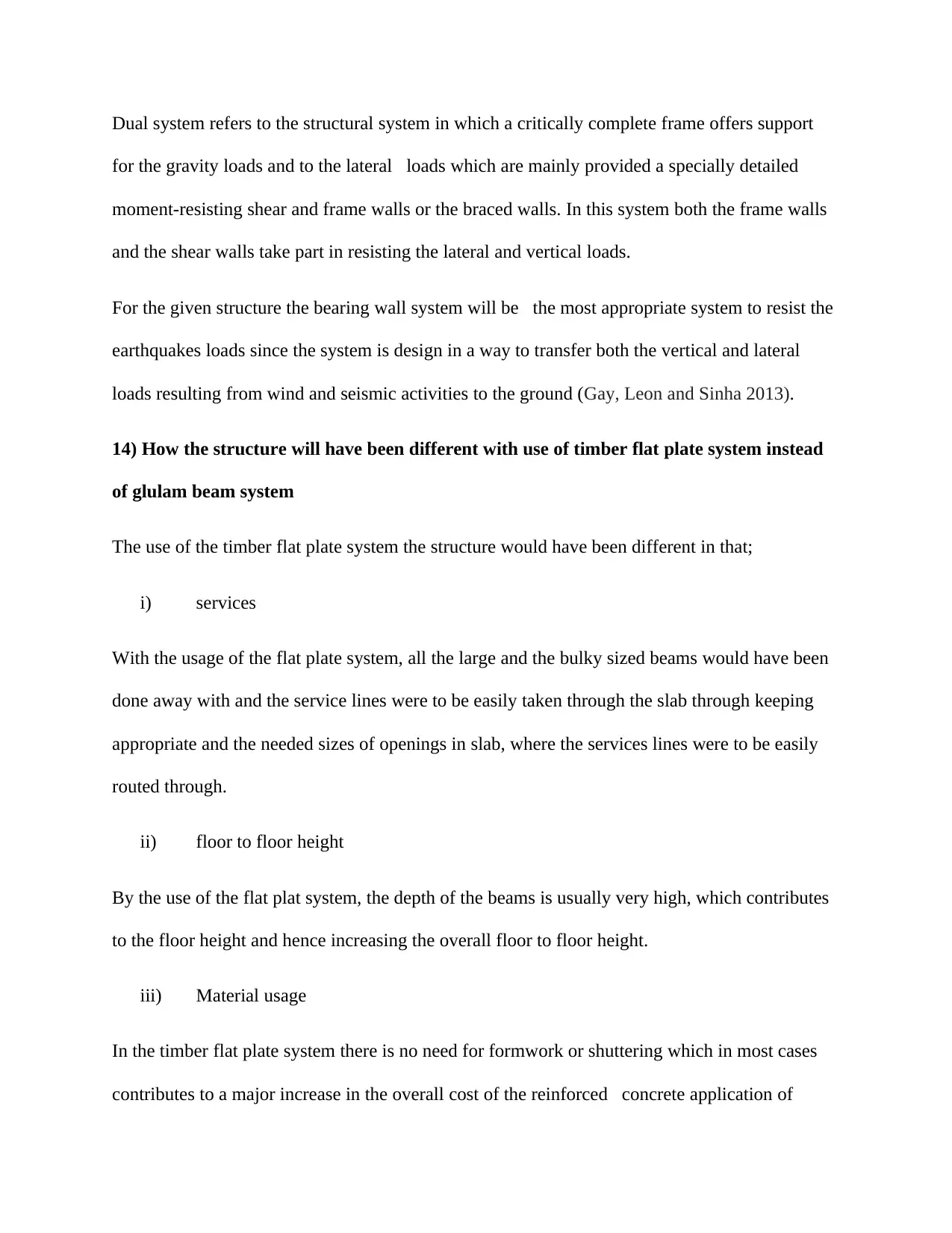
Dual system refers to the structural system in which a critically complete frame offers support
for the gravity loads and to the lateral loads which are mainly provided a specially detailed
moment-resisting shear and frame walls or the braced walls. In this system both the frame walls
and the shear walls take part in resisting the lateral and vertical loads.
For the given structure the bearing wall system will be the most appropriate system to resist the
earthquakes loads since the system is design in a way to transfer both the vertical and lateral
loads resulting from wind and seismic activities to the ground (Gay, Leon and Sinha 2013).
14) How the structure will have been different with use of timber flat plate system instead
of glulam beam system
The use of the timber flat plate system the structure would have been different in that;
i) services
With the usage of the flat plate system, all the large and the bulky sized beams would have been
done away with and the service lines were to be easily taken through the slab through keeping
appropriate and the needed sizes of openings in slab, where the services lines were to be easily
routed through.
ii) floor to floor height
By the use of the flat plat system, the depth of the beams is usually very high, which contributes
to the floor height and hence increasing the overall floor to floor height.
iii) Material usage
In the timber flat plate system there is no need for formwork or shuttering which in most cases
contributes to a major increase in the overall cost of the reinforced concrete application of
for the gravity loads and to the lateral loads which are mainly provided a specially detailed
moment-resisting shear and frame walls or the braced walls. In this system both the frame walls
and the shear walls take part in resisting the lateral and vertical loads.
For the given structure the bearing wall system will be the most appropriate system to resist the
earthquakes loads since the system is design in a way to transfer both the vertical and lateral
loads resulting from wind and seismic activities to the ground (Gay, Leon and Sinha 2013).
14) How the structure will have been different with use of timber flat plate system instead
of glulam beam system
The use of the timber flat plate system the structure would have been different in that;
i) services
With the usage of the flat plate system, all the large and the bulky sized beams would have been
done away with and the service lines were to be easily taken through the slab through keeping
appropriate and the needed sizes of openings in slab, where the services lines were to be easily
routed through.
ii) floor to floor height
By the use of the flat plat system, the depth of the beams is usually very high, which contributes
to the floor height and hence increasing the overall floor to floor height.
iii) Material usage
In the timber flat plate system there is no need for formwork or shuttering which in most cases
contributes to a major increase in the overall cost of the reinforced concrete application of
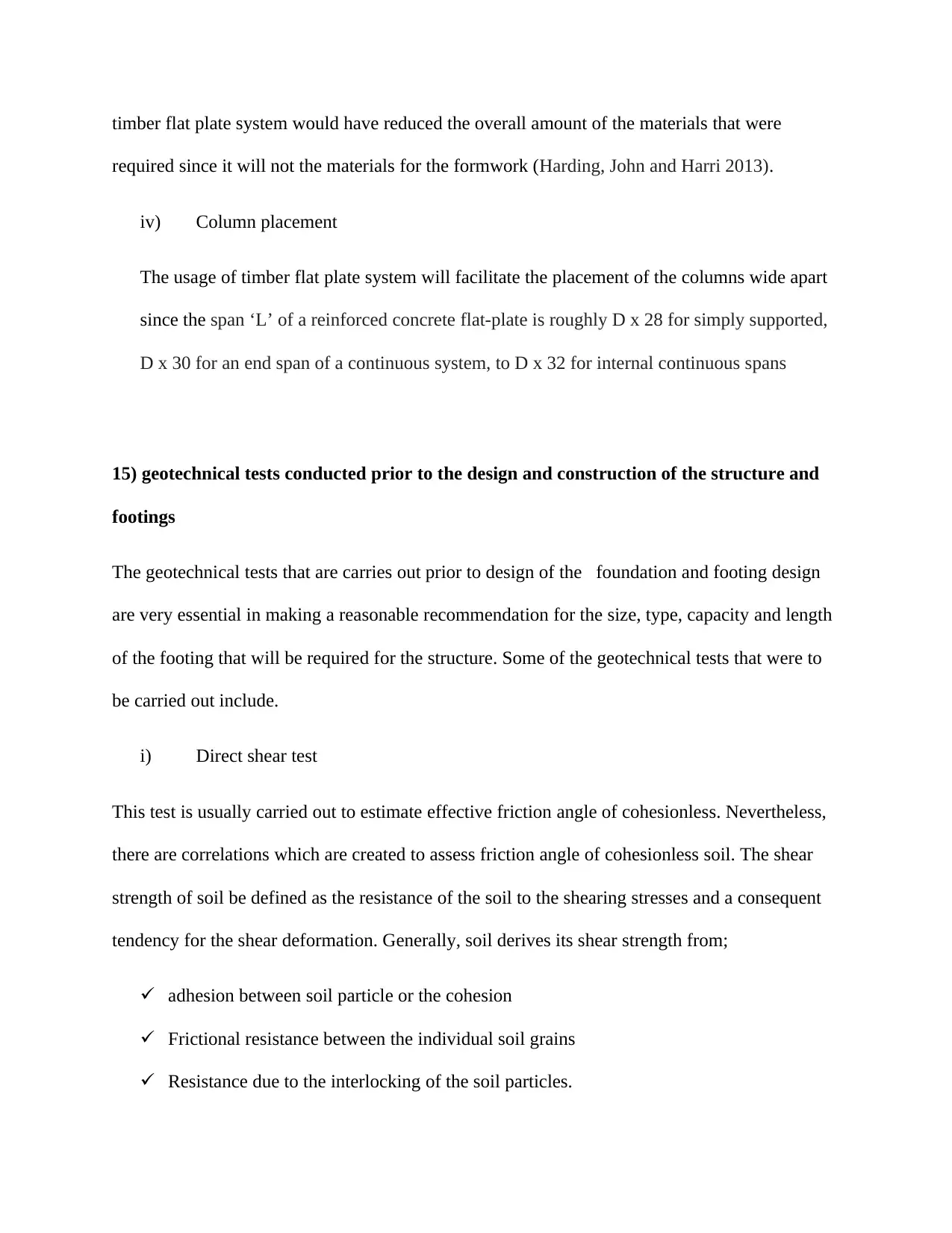
timber flat plate system would have reduced the overall amount of the materials that were
required since it will not the materials for the formwork (Harding, John and Harri 2013).
iv) Column placement
The usage of timber flat plate system will facilitate the placement of the columns wide apart
since the span ‘L’ of a reinforced concrete flat-plate is roughly D x 28 for simply supported,
D x 30 for an end span of a continuous system, to D x 32 for internal continuous spans
15) geotechnical tests conducted prior to the design and construction of the structure and
footings
The geotechnical tests that are carries out prior to design of the foundation and footing design
are very essential in making a reasonable recommendation for the size, type, capacity and length
of the footing that will be required for the structure. Some of the geotechnical tests that were to
be carried out include.
i) Direct shear test
This test is usually carried out to estimate effective friction angle of cohesionless. Nevertheless,
there are correlations which are created to assess friction angle of cohesionless soil. The shear
strength of soil be defined as the resistance of the soil to the shearing stresses and a consequent
tendency for the shear deformation. Generally, soil derives its shear strength from;
adhesion between soil particle or the cohesion
Frictional resistance between the individual soil grains
Resistance due to the interlocking of the soil particles.
required since it will not the materials for the formwork (Harding, John and Harri 2013).
iv) Column placement
The usage of timber flat plate system will facilitate the placement of the columns wide apart
since the span ‘L’ of a reinforced concrete flat-plate is roughly D x 28 for simply supported,
D x 30 for an end span of a continuous system, to D x 32 for internal continuous spans
15) geotechnical tests conducted prior to the design and construction of the structure and
footings
The geotechnical tests that are carries out prior to design of the foundation and footing design
are very essential in making a reasonable recommendation for the size, type, capacity and length
of the footing that will be required for the structure. Some of the geotechnical tests that were to
be carried out include.
i) Direct shear test
This test is usually carried out to estimate effective friction angle of cohesionless. Nevertheless,
there are correlations which are created to assess friction angle of cohesionless soil. The shear
strength of soil be defined as the resistance of the soil to the shearing stresses and a consequent
tendency for the shear deformation. Generally, soil derives its shear strength from;
adhesion between soil particle or the cohesion
Frictional resistance between the individual soil grains
Resistance due to the interlocking of the soil particles.
⊘ This is a preview!⊘
Do you want full access?
Subscribe today to unlock all pages.

Trusted by 1+ million students worldwide
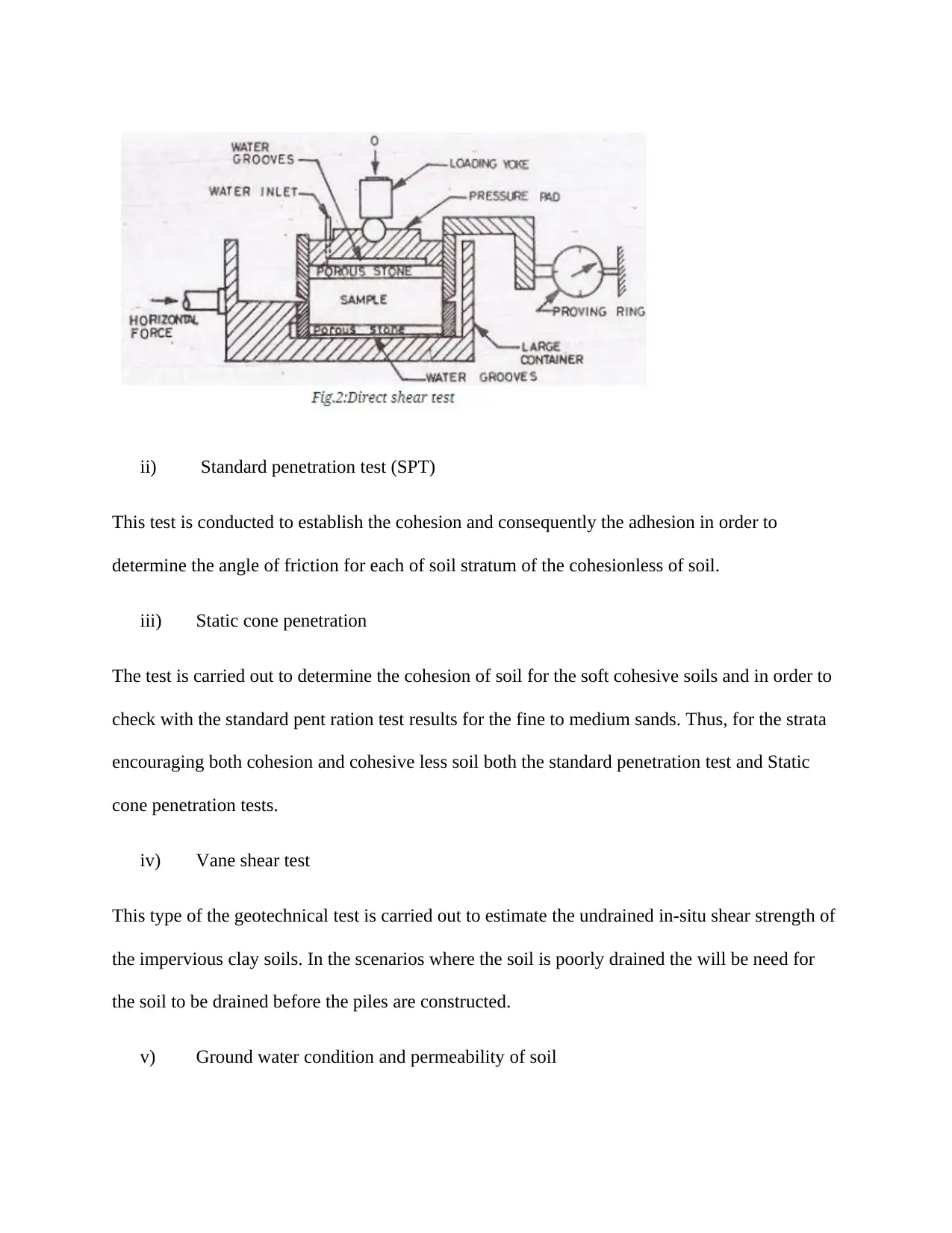
ii) Standard penetration test (SPT)
This test is conducted to establish the cohesion and consequently the adhesion in order to
determine the angle of friction for each of soil stratum of the cohesionless of soil.
iii) Static cone penetration
The test is carried out to determine the cohesion of soil for the soft cohesive soils and in order to
check with the standard pent ration test results for the fine to medium sands. Thus, for the strata
encouraging both cohesion and cohesive less soil both the standard penetration test and Static
cone penetration tests.
iv) Vane shear test
This type of the geotechnical test is carried out to estimate the undrained in-situ shear strength of
the impervious clay soils. In the scenarios where the soil is poorly drained the will be need for
the soil to be drained before the piles are constructed.
v) Ground water condition and permeability of soil
This test is conducted to establish the cohesion and consequently the adhesion in order to
determine the angle of friction for each of soil stratum of the cohesionless of soil.
iii) Static cone penetration
The test is carried out to determine the cohesion of soil for the soft cohesive soils and in order to
check with the standard pent ration test results for the fine to medium sands. Thus, for the strata
encouraging both cohesion and cohesive less soil both the standard penetration test and Static
cone penetration tests.
iv) Vane shear test
This type of the geotechnical test is carried out to estimate the undrained in-situ shear strength of
the impervious clay soils. In the scenarios where the soil is poorly drained the will be need for
the soil to be drained before the piles are constructed.
v) Ground water condition and permeability of soil
Paraphrase This Document
Need a fresh take? Get an instant paraphrase of this document with our AI Paraphraser
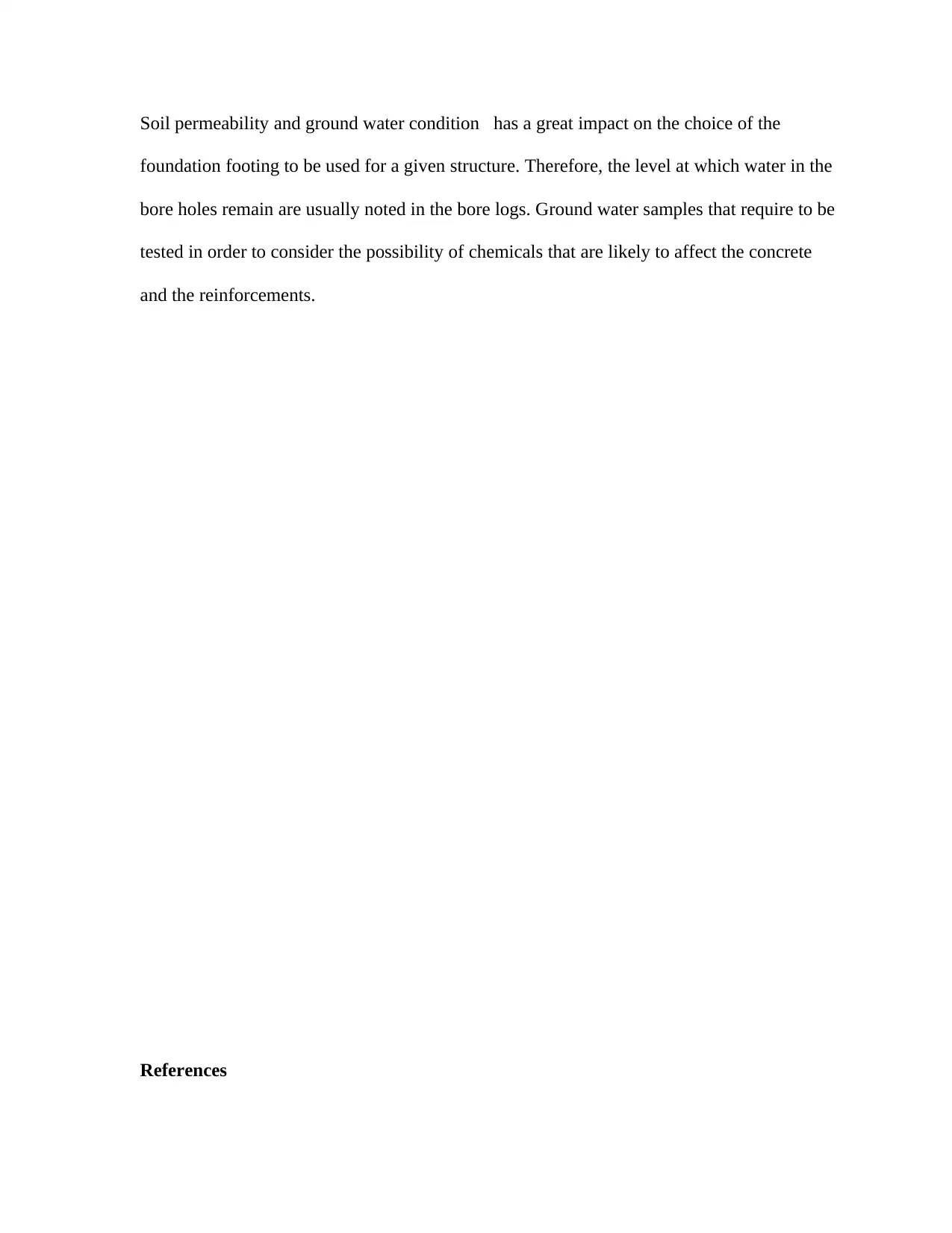
Soil permeability and ground water condition has a great impact on the choice of the
foundation footing to be used for a given structure. Therefore, the level at which water in the
bore holes remain are usually noted in the bore logs. Ground water samples that require to be
tested in order to consider the possibility of chemicals that are likely to affect the concrete
and the reinforcements.
References
foundation footing to be used for a given structure. Therefore, the level at which water in the
bore holes remain are usually noted in the bore logs. Ground water samples that require to be
tested in order to consider the possibility of chemicals that are likely to affect the concrete
and the reinforcements.
References
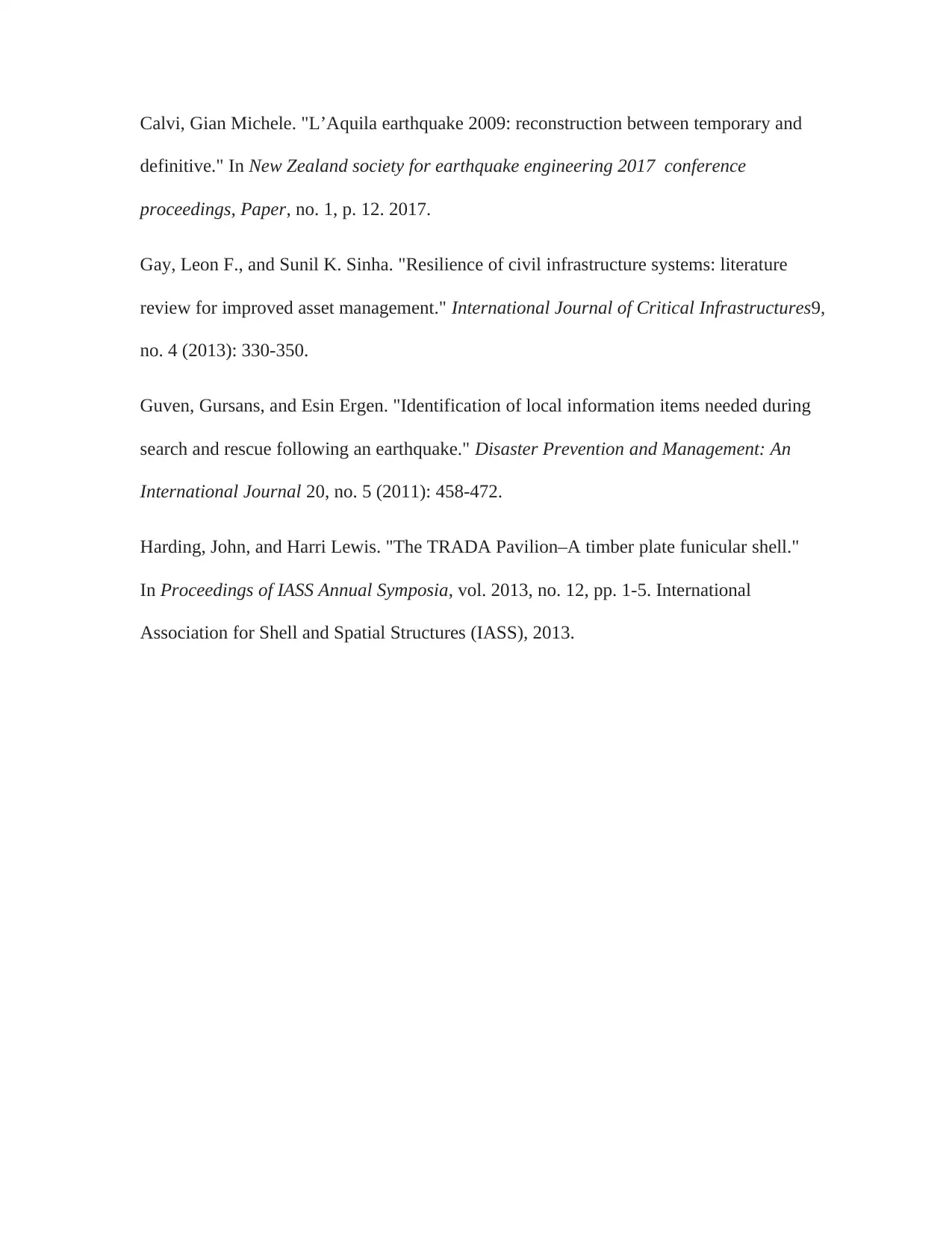
Calvi, Gian Michele. "L’Aquila earthquake 2009: reconstruction between temporary and
definitive." In New Zealand society for earthquake engineering 2017 conference
proceedings, Paper, no. 1, p. 12. 2017.
Gay, Leon F., and Sunil K. Sinha. "Resilience of civil infrastructure systems: literature
review for improved asset management." International Journal of Critical Infrastructures9,
no. 4 (2013): 330-350.
Guven, Gursans, and Esin Ergen. "Identification of local information items needed during
search and rescue following an earthquake." Disaster Prevention and Management: An
International Journal 20, no. 5 (2011): 458-472.
Harding, John, and Harri Lewis. "The TRADA Pavilion–A timber plate funicular shell."
In Proceedings of IASS Annual Symposia, vol. 2013, no. 12, pp. 1-5. International
Association for Shell and Spatial Structures (IASS), 2013.
definitive." In New Zealand society for earthquake engineering 2017 conference
proceedings, Paper, no. 1, p. 12. 2017.
Gay, Leon F., and Sunil K. Sinha. "Resilience of civil infrastructure systems: literature
review for improved asset management." International Journal of Critical Infrastructures9,
no. 4 (2013): 330-350.
Guven, Gursans, and Esin Ergen. "Identification of local information items needed during
search and rescue following an earthquake." Disaster Prevention and Management: An
International Journal 20, no. 5 (2011): 458-472.
Harding, John, and Harri Lewis. "The TRADA Pavilion–A timber plate funicular shell."
In Proceedings of IASS Annual Symposia, vol. 2013, no. 12, pp. 1-5. International
Association for Shell and Spatial Structures (IASS), 2013.
⊘ This is a preview!⊘
Do you want full access?
Subscribe today to unlock all pages.

Trusted by 1+ million students worldwide
1 out of 6
Related Documents
Your All-in-One AI-Powered Toolkit for Academic Success.
+13062052269
info@desklib.com
Available 24*7 on WhatsApp / Email
![[object Object]](/_next/static/media/star-bottom.7253800d.svg)
Unlock your academic potential
Copyright © 2020–2025 A2Z Services. All Rights Reserved. Developed and managed by ZUCOL.





